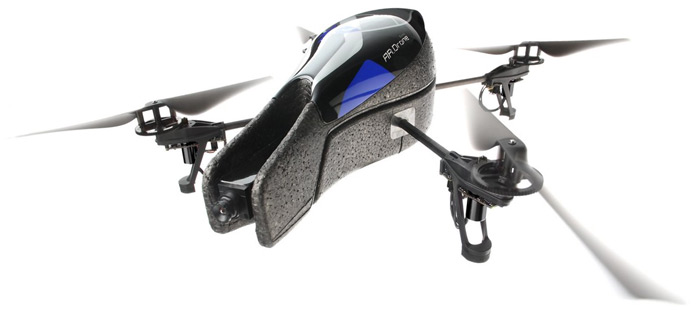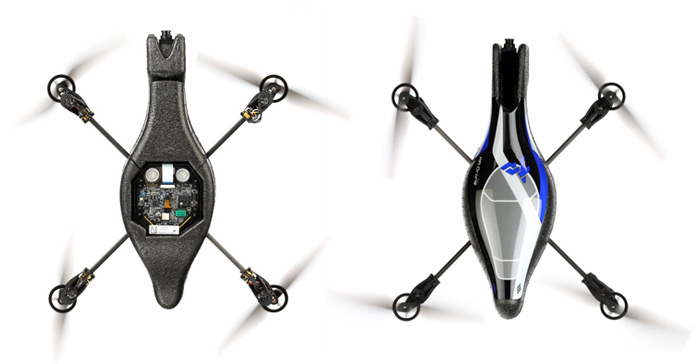
This small quadcopter called AR.Drone could be the killer app for small commercial drones. Since it appeared on the internet and at CES/Las Vegas some days ago it created a huge buzz and even without a price or a availability date everybody seem to want one. In this post there is a general description and (if possible) a first general validation of the actual product and its possible effects.---

The AR.Drone follows the general design of many other quadcopters (a very popular UAV / RC type). It has 4 rotors attached to the fuselage via carbon fiber tubes. The motors are either brushed or brushless (depending on the price) and geared to the plastic proppelers. They have a safety lock in the event of a touch and draw around 15W of power from a 1000mAh Li-pol battery. The fuselage is plastic and EPP and the drone weigh 360gr or 400gr with the optional fan cowl for the propellers (for indoor use).
All the above are quite standard and not very expensive. The most high tech feature of the AR.Drone is the electronics. The core system is a powerful 468MHz ARM9 RISC 32Bit processor with 128MB of DDR RAM running a customized Linux (!) distribution.
For stabilization and guidance it has a complex system with a 6doF IMU (with one 3-axis accelerometer, one 2-axis gyrometer and a 1-axis gyrometer), two 40kHz Ultrasound altimeters and a down looking CMOS video camera.
This three way system uses the IMU for stabilization and fly by wire flight in the 3d space, the ultrasound for detecting its vertical position and the high speed camera for detecting its longitudinal speed. The camera function works in a principle similar to that of the optical mouse, by detecting the difference in images it senses the direction and speed of movement.

With the systems described above we have a very competent quadcopter that can be stable in flight and have some level of automatation (auto landing and hovering). What made the AR.Drone the Internet star is the user interface.
Parrot made a smart move and instead of providing a dedicated control device it used the iphone or ipod touch to control the drone. The AR.Drones mainboard has a wi-fi system that can be linked to the iphone. Through this wi-fi the user can control the drone from the touchscreen and by moving and tilting the iphone. The drone also has a second camera in the front that captures video (VGA quality in 15fps) and transmits it to the iphone. If the connection is lost the drone can hover and land safely by itself.
All these combined make the AR.Drone a full FPV quadcopter that is controlled through the iphone with the installed app. Parrot can piggyback the iphone's huge userbase (and one can say the iphone hype) by this link but it goes one step further.
With its powerful computer system the AR.Drone is true to its name by being able to overlay graphics over the video stream by allowing the user to play games of augmented reality, even with other AR.Drone users.
[ytx="2aDE5GcriHc"]2aDE5GcriHc[/ytx]
Augmented reality is mostly appreciated if the additional data is overprojected to the actual real experience (a simple example is the HUD on planes or cars). This application is a little overkill. The user is playing a simple videogame and the purpose of this advanced quadcopter only adds a real and live video background.
I personally think that the most interesting feature of the AR.Drone is neither the iphone integration, nor the AR game applications but the fact that Parrot offers an open SDK allowing the drone to be developped by its customers with a huge span of applications.
The AR.Drone has captured the attention of an audience much broader than the usual RC or UAV hobbyist. If it will be sold in a affordable price for such a competent product it will surely transform the market.
AR.Drone overview :
[ytx="_Ejh--_56ic"]_Ejh--_56ic[/ytx]
[COLOR="Magenta"]Update: You can listen a very interesting discussion with Parrot CEO Henri Seydoux from [/COLOR]DIYdrones.com podcast[COLOR="Magenta"] (direct links: [/COLOR]mp3[COLOR="Magenta"] , [/COLOR] aac[COLOR="Magenta"]) [/COLOR]